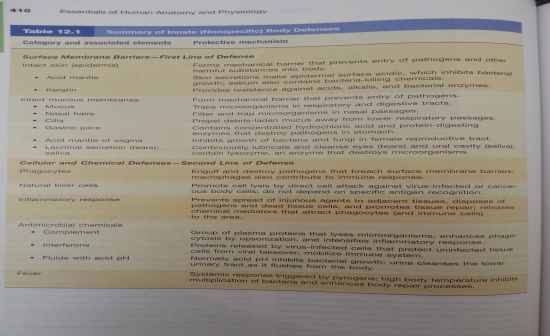Cards In This Set
| Front | Back |
|
What are the defense systems for removal of foreign substance (???)
|
Antigens - Innate (non-specific) (1 and 2)
* protects against anything foreign to the body * responds immediately Adaptive (specfic) (immune system) (3) * against particular foreign substances * needs to be primed by initial exposure to antigen |
|
Draw a table of the immune system
|
|
|
Describe the first line of defense
|
 (Innate) * The skin - Physcial barrier to foreign materials - pH of the skin is acidic to inhibit bacterial growth - Sebum is toxic to bacteria - Keratin blocks entry of foreign matter * Stomach mucosa - secretes hydrochloic acid - has protein-digesting enzymes * Saliva and lacrimal fluid contain lysozyme * Mucus traps microorganisms in digestive and respiratory pathways |
|
What is lacrimal fluid?
|
Fluid of the eyes containing antibacterial enzymes in it (Tears)
|
|
Describe the second line of defense
|
(innate)
*Phagocytes (eat) - neutophils and macrophages - engulfs foreign material into a vacuole - enzymes from lysosomes digest the material * Natural killer cells (can kill bodies bad cells) - can luse and kill cancer cells - can destroy virus-infected cells - not phagocytic (they inject with chemical not engulf) - chemical attack - perforins * Inflammatory Response - triggered when body tissues are injured - produces four cardinal signs ^ Readness ^ Heat ^ Swelling ^ Pain - Results in a chain of events leading to protection and healing * Fever - Abnormally high body temp - Systemic response to invading antigens - WBC and acrophages secrete "pyrogens" - Benefits the body - disadvantages bacteria |
|
What are neutophils and macrophages?
|
Types of white blood cells
|
|
Draw how the phagocyte works
|
|
|
What is a phagocyte?
|
A white blood cell that engulfs, destorys and spits out foreign bodies
|
|
What are the four cardinal signs?
|
Redness Heat Swelling Pain
|
|
Draw a flow chart of the inflammatory response (just a guide)
|
- Abnormally high body temp - Systemic response to invading antigens - WBC and acrophages secrete "pyrogens" - Benefits the body - disadvantages bacteria |
|
Describe inflammation
|
Increased blood flow to the area - hyperemia
Brings more oxygen and nutrients for repair Brings white blood cells to the area Brings clotting proteins to the area to contain injury Disposes of cell debris and pathogens Sets the stage for repair |
|
Describe a fever
|
- Abnormally high body temp
- Systemic response to invading antigens - WBC and acrophages secrete "pyrogens" - Benefits the body - disadvantages bacteria |
|
Describe natural killers
|
Natural killer cells (can kill bodies bad cells)
- can luse and kill cancer cells - can destroy virus-infected cells - not phagocytic (they inject with chemical not engulf) - chemical attack - perforins |
|
Describe phagocytes
|
*Phagocytes (eat) - neutophils and macrophages
- engulfs foreign material into a vacuole - enzymes from lysosomes digest the material |
|
Describe the 3rd Line of defense
|
(Adaptive)
* Involves specific B and T lymphocytes * Antigen specific - recognizes and acts against particular foreign substances * Systemic - not restricted to the inital infection site * Has memory - recognizes and mounts a stronger attack on previously encountered pathogens * Humoral immunity ( found in the blood) - B cells - antibody-mediated immunity (helps) - targets antigens free in the body fluids * Cellular immunity - T cells (direct combat cell vs cell) - cell-mediated immunity - cell targets virus infected cells (antigen inside cell) |



